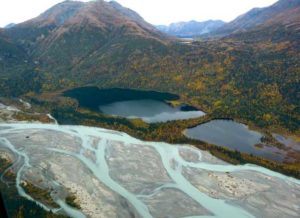
(Anchorage) — Last week, Alaska Governor Mike Dunleavy announced a lawsuit that asks the courts to recognize the State’s ownership to submerged lands within Lake Clark National Park and Preserve, an ownership granted at Statehood but not yet fully recognized by the federal government. Governor Dunleavy also announced Notice of Trespass and cease-and-desist letters recently sent to the Agriculture and Interior Departments for federal infrastructure, such as docks, that lacks permits on State-owned submerged lands. Both actions are part of Governor Dunleavy’s “Unlocking Alaska Initiative,” which began a year ago to secure Alaska’s submerged lands and navigable waterways.
“State submerged lands are how many Alaskans access health care services, visit family or friends, recreate, shop in other communities, and hunt or fish. You should be able to enjoy our waters without being harassed by the federal government,” said Governor Dunleavy. “Yet despite two unanimous Supreme Court rulings and defining law from 63 years ago when Alaska became a state, the federal government continues to act in a manner contrary to law. When it does, we’re going to assert ourselves. I will fight for every acre owed to Alaskans.”
To date, the federal government has acknowledged the State’s title to only nine percent of Alaska’s submerged lands under 800,000 miles of navigable rivers, and 16 percent of Alaska’s submerged lands under 30 million acres of navigable lakes.
Alaska Deputy Attorney General Cori Mills said the federal government remains evasive on requests for title.
“There is a misconception that these actions are to take away land from the federal government and give it to the State—this is false,” Mills said. “Alaska was already given these submerged lands—the federal government just refuses to rightfully recognize it. This would be similar to your neighbor asserting that your driveway may not actually be your property, despite a clearly demarcated boundary line on a survey map.”
In the Submerged Lands Act (SLA) the federal government promised all states the right to own lands and resources beneath navigable (usable for transportation or commerce at statehood) lakes, rivers, and offshore waters. Rights under the SLA are acquired immediately at the time of statehood and cannot be arbitrarily denied or taken away later by the federal government.
Alaska Department of Natural Resources Commissioner Corri Feige said through Alaska’s Congressional Delegation, the State has undertaken an audit of the U.S. Department of the Interior (DOI) with the Government Accountability Office. The audit seeks how the funds, specifically appropriated by Congress, for the express purpose of expediting Alaska land conveyances and resolution of navigability title matters have been spent. This action is appropriate given the lack of action by DOI, which has received more than $118,000,000 since federal fiscal year 2018 for this purpose.
Commissioner Feige also gave an overview of the challenges of acquiring a list of federal infrastructure situated on State-owned navigable waterways.
“Despite repeated conversations with federal agencies over the past year, we have yet to receive a clear picture of what federal infrastructure is located on State submerged lands,” said Feige. “The lack of cooperation in providing this information is why we have sent cease-and-desist letters to the U.S. Forest Service that seeks to prohibit motorized boat operation at Mendenhall Lake and have filed Notice of Trespass to the National Park Service for the unauthorized construction of a dock at Crescent Lake in Lake Clark National Park and Preserve.”
She highlighted two bills moving through committees now in Juneau that seek to codify the acreage of State submerged lands, Senate Bill 227 and House Bill 397.
In another example of federal overreach, Alaskan John Sturgeon was told he could not operate his 10-foot hovercraft on State navigable waters when he was moose hunting in 2007 on the Nation River, a tributary of the Yukon River near the Canadian border. Sturgeon fought to preserve his access on State waters for 13 years and drew financial support from thousands of Alaskans for $1.6 million in legal costs to see two cases through to unanimous victories at the U.S. Supreme Court in 2016 and 2019.
Sturgeon quoted Justice Elena Kagan who described the importance of Alaska’s navigable waters for transportation. “And rivers function as the roads of Alaska, to an extent unknown anyplace else in the country. Over three-quarters of Alaska’s 300 communities live in regions unconnected to the State’s road system. Residents of those areas include many of Alaska’s poorest citizens, who rely on rivers for access to necessities like food and water,” Sturgeon read.
In addition, submerged lands belonging to the State do not count toward the total amount of land a state is entitled to receive from the federal government. The latest estimate is 100,000 acres of submerged lands that Alaska has been wrongfully allocated as conveyed lands. Governor Dunleavy’s administration is working to address this restitution.
“This makes it incredibly important that submerged lands belonging to the State are accurately identified and counted. Only then will the total amount of land the State can select not be unlawfully diminished,” said Governor Dunleavy.
Click to view the news conference slides, an example of a cease-and-desist letter, a letter to U.S. Secretary of Interior Deb Haaland, an example of a No Trespass Notice, notice of litigation for Mendenhall Lake and River, a list of other submerged lands litigation, and a copy of the lawsuit on Lake Clark National Park & Preserve.
###
